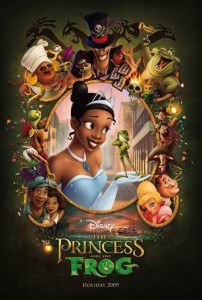
After reading and hearing various reviews, yesterday I made my way to the $1.50 Theater to see Disney’s “The Princess and the Frog.” I have to admit that I went in expecting not to really care for the movie, and came away pleasantly surprised. It is a good story told well, and has enough plot twists to keep it from being predictable.
Parents should be well aware that the villain, Dr. Facilier (whose name is a clever derivation from the word facile, meaning “easily accomplished or attained,” or “shallow”) is a dark and sinister character, who calls upon his “friends on the other side.” These friends, manifest as voodoo heads and shadowy sprits, can be quite frightening for younger children, and is primarily why it will be a few years before my boys see this movie (the oldest is six). While some parents may be upset by the clear references to the occult, however, there isn’t any doubt that they are evil. Granted, Dr. Facilier’s initial singing performance is quite catchy and impressive, but that only adds to the lesson to be learned that sometimes evil can be very appealing (fitting perfectly with the temptation scene taking place). In the end Dr. Facilier reaps what he sows, and his demise (another darkly intense scene) is a profound picture of what happens to those who attempt to befriend and manipulate evil. To put it simply, the bad guy is really bad, and to have that clear demarcation in the story was oddly refreshing since so many movies attempt to blur the lines between good and evil.
Tiana, the heroine of the story, is worthy of emulation. Raised in a loving home by her father and mother, she is taught the importance of a good work ethic, but not to the exclusion of what matters more: love and family. Her development as a character comes to its climax when she realizes that she had forgotten her father’s instruction, and is able to overcome Dr. Facilier’s temptation as a result.
There are a number of other interesting images throughout the movie: light overcoming darkness; sacrificial death and love (evidenced even in the shallowest of characters); and a scene in which a star named “Evangeline” (which means “gospel”) is thanked by Naveen (the prince turned frog) for saving his life.
Perhaps one of the most interesting scenes is with Mama Odie in the middle of the swamp. Dressed in white (so you know she’s good), this blind, voodoo magician plays more the part of a Pentecostal (snake-handling?) preacher who challenges Tiana and Naveen to “Dig a Little Deeper” to discern between what they want and what they really need. While neither of them is able to correctly answer at the time, their growing relationship and influence on one another enables each of them to answer that question when it matters most. (Naveen’s rolling up his sleeve toward the end of the movie is a nice touch along these lines, too.)
The music doesn’t rise to the level of “The Little Mermaid” or “Beauty & the Beast,” but the jazz style is fun and quite fitting to the New Orleans setting. Also, clever one-liners and animation make for some subtle humor that adults are more likely to catch and enjoy. I do find it interesting that Caucasians are represented rather negatively throughout, even though the stereotypes are not completely unfounded. On the whole, The Princess and the Frog is an enjoyable movie that easily provides a number of proverbial discussion points with (older) kids.